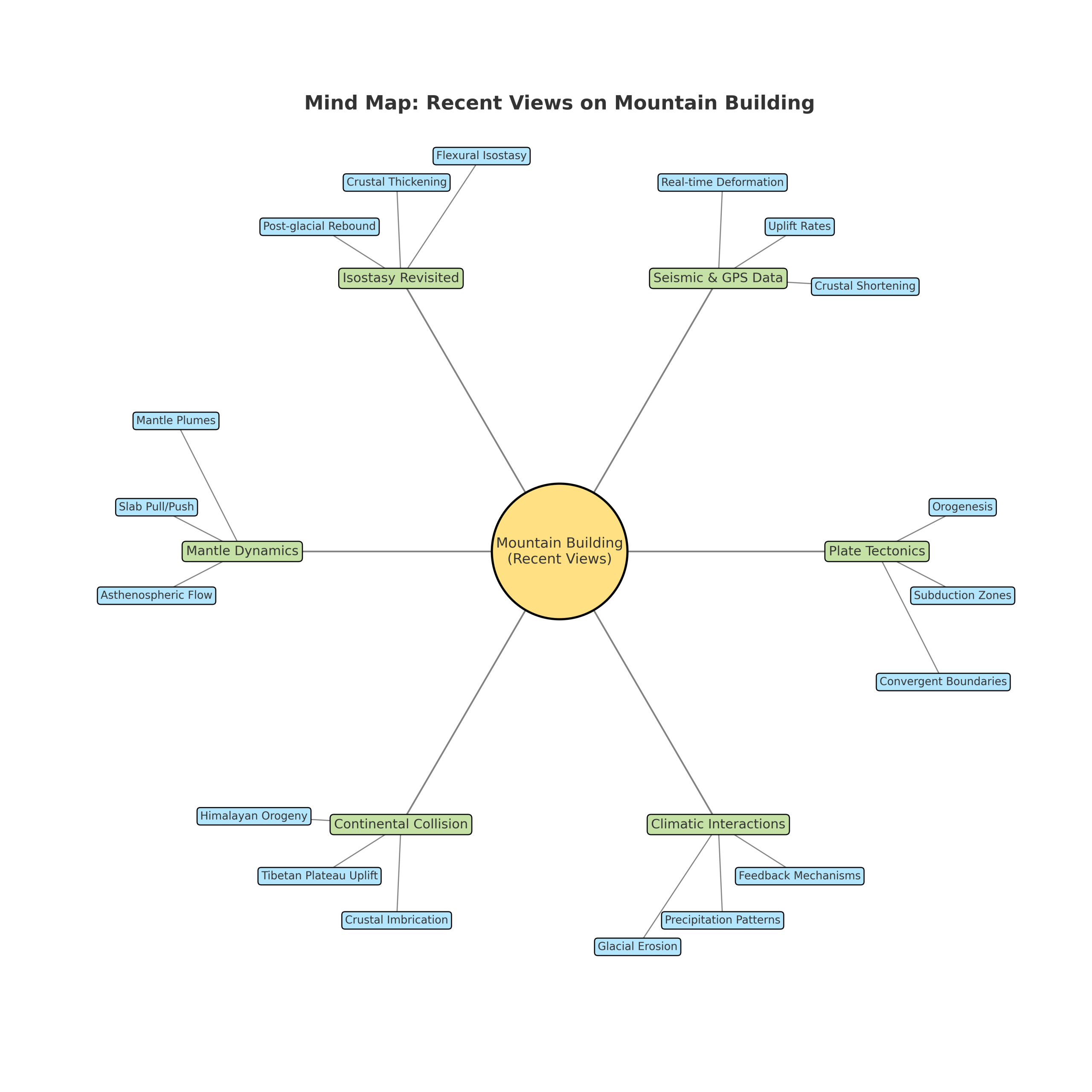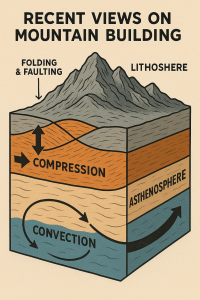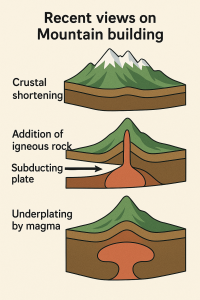
23 Jul Recent views on Mountain building
Recent Views on Mountain Building – UPSC Geography Optional Notes
Mountain building, or orogeny, is a complex geological process that shapes the Earth’s topography. While earlier theories emphasized vertical movements (e.g., geosynclinal theory), modern views integrate plate tectonics, isostasy, mantle dynamics, and climatic influences. This article provides a detailed explanation of recent views on mountain building for UPSC CSE Geography Optional (Paper 1).

Mountain Building Views
1. Plate Tectonics and Orogenesis
Plate tectonics remains the cornerstone of modern mountain building theories. It proposes that mountains form primarily at convergent plate boundaries:
- Continental-continental convergence (e.g., Himalayas)
- Oceanic-continental subduction (e.g., Andes)
- Oceanic-oceanic subduction (e.g., island arcs)
This interaction causes crustal thickening, folding, faulting, and uplift – key characteristics of orogenesis.
Best geography optional coaching
Best geography optional teacher
Best geography optional test series
2. Mantle Convection and Mountain Building
Advancements in seismology and geodynamics have emphasized the role of mantle convection as a driving force behind plate movements. Features include:
- Upwelling plumes lifting continental lithosphere (e.g., East African Rift)
- Slab pull and slab push mechanisms affecting subduction
- Interaction of lithospheric plates with asthenospheric flow
3. Isostasy and Flexural Mountain Belts
The concept of isostasy is re-evaluated with the flexural model, which treats the lithosphere as an elastic plate over the asthenosphere. Important observations include:
- Mountain roots act like icebergs – deeper roots support taller mountains (Airy Model)
- Density differences also cause elevation variation (Pratt Model)
- Post-glacial rebound and crustal compensation contribute to vertical adjustments

Recent Views on Mountain Building
4. GPS and Satellite Observations
Modern technologies like GPS and InSAR provide real-time data on orogeny. Applications include:
- Measuring crustal shortening and uplift rates
- Tracking earthquake-generating strain zones
- Understanding mountain evolution through time-lapse imagery
5. Climatic and Erosional Feedbacks
Recent models integrate climatic factors with tectonics. The tectonic-climate coupling theory suggests:
- Glacial erosion enhances relief, exposing crust to further uplift
- Heavy rainfall in orographic zones accelerates river incision
- Feedback loops between erosion and uplift affect mountain longevity
6. Continental Collision and Large-Scale Orogeny
New insights into continental collisions include:
- Crustal doubling and thickening in Himalayas
- Tibetan Plateau uplift due to underthrusting Indian Plate
- Formation of syntaxes and crustal imbrication
7. Case Studies
- Himalayas: World’s youngest and tallest fold mountain system
- Andes: Volcanic mountain chain formed by subduction
- Rockies: Result of shallow-angle subduction and compression
8. Previous Year Questions (PYQs) – UPSC CSE
- 2020: Discuss the plate tectonic theory and its relevance to mountain building.
- 2017: Examine the role of isostasy and plate tectonics in the evolution of mountains.
- 2014: Explain the mechanisms of mountain building with suitable examples.
- 2011: Evaluate the contribution of plate tectonics to the understanding of orogenesis.
9. Probable Questions for UPSC Mains 2025
- Discuss the recent developments in understanding mountain building processes using GPS and seismic data.
- Evaluate the role of climatic factors in mountain building and evolution.
- Explain the concept of flexural isostasy and its significance in orogenesis.
- Bring out the tectonic history of the Himalayas with reference to continental collision models.
10. Probable Questions for UPSC Prelims 2026
- Which of the following instruments is used to measure crustal deformation?
- The concept of “crustal doubling” is associated with which mountain system?
- Which of the following is not a direct result of plate tectonic convergence?
11. Conclusion
Recent views on mountain building represent a multidisciplinary integration of tectonics, geophysics, climatology, and remote sensing. UPSC aspirants should focus on the dynamic, layered explanation of orogenesis to write high-quality answers in Geography Optional Paper 1.
Graduation degree with IAS coaching




No Comments